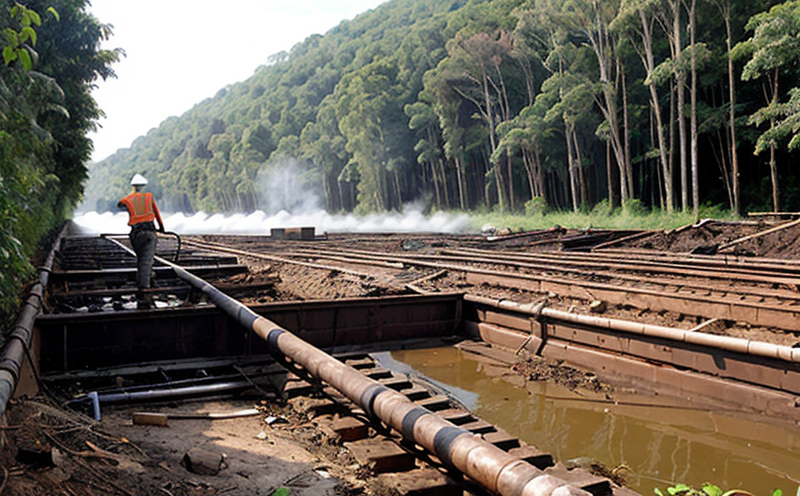EPA 322 Environmental Risk Audit for Soil Contamination Test
The EPA (Environmental Protection Agency) 322 Environmental Risk Audit for Soil Contamination is a critical service aimed at ensuring compliance with federal and state regulations regarding soil contamination. This audit not only identifies the presence of hazardous substances but also evaluates their potential risks to human health and the environment.
This process typically involves several key steps, including site assessment, sampling, analysis, and risk characterization. Site assessment helps in identifying areas that need testing by evaluating historical records, land use, and environmental conditions. Sampling is conducted using various methods depending on the suspected contaminants; this could range from surface soil samples to deep core samples.
The collected samples are then analyzed according to specific protocols laid out in EPA 322 guidelines. These protocols ensure consistency across different laboratories conducting similar tests. Once analysis is complete, risk characterization evaluates whether the levels of contamination pose a significant threat. If risks are identified, further corrective actions may be recommended.
Quality assurance plays an essential role throughout this process to maintain accuracy and reliability in results. This includes proper chain-of-custody procedures for sample handling, calibration checks for analytical instruments, and validation of methods used during testing. The ultimate goal is to provide stakeholders with accurate data that can inform decisions about necessary actions.
The importance of such audits cannot be overstated given the severe consequences of soil contamination on both public health and ecological systems. By adhering strictly to EPA 322 standards, we contribute significantly towards maintaining safe environments free from harmful pollutants.
Understanding the nuances involved in conducting an EPA 322 audit is crucial for those responsible for environmental compliance within organizations. Whether you're a quality manager overseeing internal protocols or a compliance officer ensuring adherence to external regulations, familiarity with this procedure ensures that proper measures are taken whenever there's suspicion of soil contamination.
For researchers involved in product development where raw materials might come into contact with soils (e.g., agricultural equipment), understanding these processes allows for informed decision-making regarding sourcing practices. Procurement professionals can also benefit by ensuring suppliers meet stringent environmental standards, thereby contributing to broader sustainability goals within their organizations.
Quality and Reliability Assurance
The quality assurance process in an EPA 322 Environmental Risk Audit involves several stringent measures to ensure accurate results. Proper chain-of-custody procedures are followed for all samples collected during the audit, ensuring that each sample remains traceable from collection point until final analysis.
Calibration checks and validations of analytical methods are performed regularly to maintain instrument accuracy. These practices help in minimizing errors due to equipment malfunction or operator bias. Additionally, inter-laboratory comparisons ensure consistency across different testing facilities operating under similar protocols.
By adhering strictly to these quality assurance measures, we uphold the highest standards of scientific integrity and reliability when providing EPA 322 Environmental Risk Audits. Our commitment to excellence ensures that clients receive trustworthy results capable of guiding informed decision-making processes related to soil contamination issues.
Environmental and Sustainability Contributions
The implementation of an EPA 322 Environmental Risk Audit contributes significantly to environmental protection efforts by identifying hazardous substances present in soil, evaluating their potential risks, and recommending corrective actions where necessary. This proactive approach helps prevent further contamination while promoting safer working conditions.
By ensuring compliance with stringent regulatory requirements through accurate testing methods, we support broader sustainability goals within our clients' organizations. For instance, understanding the presence of harmful pollutants allows companies to make informed decisions about sourcing practices and product development, ultimately leading to more sustainable operations.
The data generated from these audits can also be used for educational purposes, helping raise awareness among employees and communities about the importance of environmental stewardship. This contributes positively towards fostering a culture of responsibility and continuous improvement in managing natural resources sustainably.
Benefits
- Comprehensive identification of hazardous substances present in soil.
- Evaluation of potential risks posed by identified contaminants.
- Identification and implementation of corrective actions necessary to mitigate identified risks.
- Achieve regulatory compliance with stringent environmental regulations like EPA 322.
- Promote sustainable practices that protect public health and biodiversity.
- Increase confidence among stakeholders regarding the safety of operations involving soil contact products.





